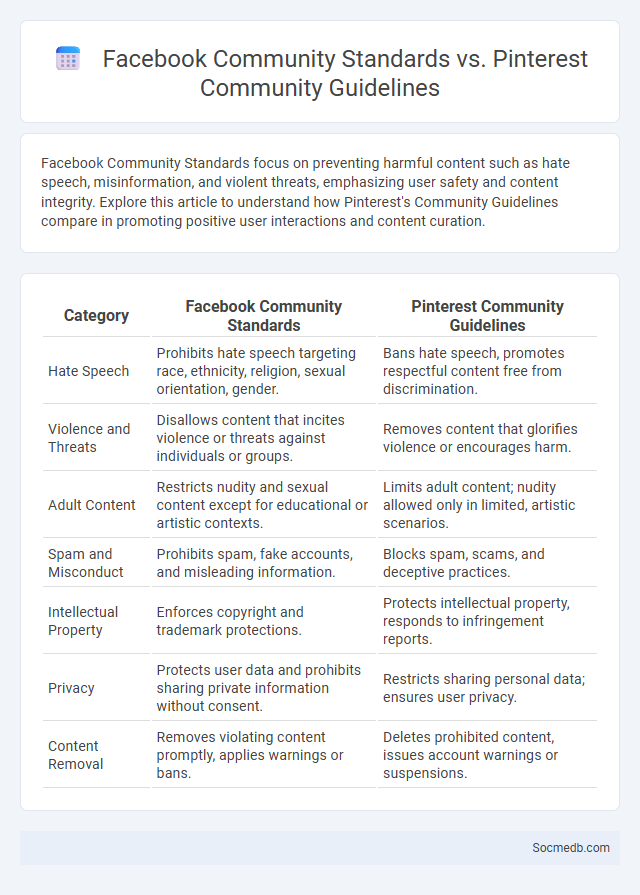
Photo illustration: Facebook Community Standards vs Pinterest Community Guidelines
Facebook Community Standards focus on preventing harmful content such as hate speech, misinformation, and violent threats, emphasizing user safety and content integrity. Explore this article to understand how Pinterest's Community Guidelines compare in promoting positive user interactions and content curation.
Table of Comparison
| Category | Facebook Community Standards | Pinterest Community Guidelines |
|---|---|---|
| Hate Speech | Prohibits hate speech targeting race, ethnicity, religion, sexual orientation, gender. | Bans hate speech, promotes respectful content free from discrimination. |
| Violence and Threats | Disallows content that incites violence or threats against individuals or groups. | Removes content that glorifies violence or encourages harm. |
| Adult Content | Restricts nudity and sexual content except for educational or artistic contexts. | Limits adult content; nudity allowed only in limited, artistic scenarios. |
| Spam and Misconduct | Prohibits spam, fake accounts, and misleading information. | Blocks spam, scams, and deceptive practices. |
| Intellectual Property | Enforces copyright and trademark protections. | Protects intellectual property, responds to infringement reports. |
| Privacy | Protects user data and prohibits sharing private information without consent. | Restricts sharing personal data; ensures user privacy. |
| Content Removal | Removes violating content promptly, applies warnings or bans. | Deletes prohibited content, issues account warnings or suspensions. |
Introduction to Social Media Community Policies
Social media community policies establish guidelines that govern user behavior, content sharing, and interaction to ensure a safe and respectful online environment. These policies address issues such as hate speech, harassment, misinformation, and copyright infringement while promoting positive engagement and compliance with legal standards. Effective enforcement of community policies enhances user trust, platform integrity, and overall digital well-being.
Overview of Facebook Community Standards
Facebook Community Standards establish clear guidelines to maintain a safe and respectful platform by prohibiting hate speech, harassment, and misinformation. The policies emphasize protecting user privacy, preventing violence, and curbing content that promotes self-harm or exploitation. Enforcement mechanisms include content removal, account restrictions, and appeals to ensure compliance and foster positive interactions.
Key Features of Pinterest Community Guidelines
Pinterest Community Guidelines emphasize respecting user privacy, prohibiting harmful content, and promoting positive interactions to maintain a safe and inclusive environment. You must avoid sharing misleading information, spam, or anything that encourages violence or hate speech. The guidelines also highlight protecting intellectual property and ensuring content aligns with Pinterest's values for a trustworthy user experience.
Defining General Community Standards Across Platforms
General community standards across social media platforms establish guidelines promoting respectful interaction, content appropriateness, and user safety. These standards typically address hate speech, harassment, misinformation, and explicit content to maintain a positive online environment. Consistency in enforcing these policies helps protect users and supports the platforms' commitment to ethical digital communication.
Content Moderation: Facebook vs Pinterest
Content moderation on Facebook utilizes advanced AI algorithms combined with a vast team of human reviewers to swiftly identify and remove harmful or inappropriate posts across billions of users, ensuring community standards are upheld. Pinterest emphasizes proactive content curation by leveraging visual recognition technology and user reports to maintain a positive and inspiration-driven environment, balancing creative expression with safety. Your experience on these platforms depends largely on their tailored moderation approaches that address distinct user behaviors and content types.
User Behavior Expectations: A Comparative Analysis
User behavior expectations on social media platforms vary significantly based on cultural, demographic, and technological factors, influencing content engagement and sharing patterns. Algorithms increasingly tailor experiences by analyzing user interaction data, promoting personalized content that aligns with individual preferences and habits. Understanding these dynamics empowers your strategic approach to optimize engagement and foster meaningful online communities.
Enforcement Mechanisms and Reporting Systems
Enforcement mechanisms on social media platforms include automated content filtering, user flagging systems, and penalty tiers ranging from content removal to account suspension. Reporting systems enable users to submit complaints about violations such as hate speech, misinformation, or harassment, which are then reviewed by moderation teams or AI algorithms. Effective enforcement relies on transparency, timely response, and clear community guidelines to maintain a safe online environment.
Addressing Hate Speech and Harassment Policies
Social media platforms implement strict hate speech and harassment policies to protect users and foster respectful online communities. Your ability to report offensive content promptly enables swift action, ensuring harmful behavior is minimized and user safety is prioritized. Enforcement of these policies includes content removal, account suspension, and ongoing monitoring to deter violations effectively.
Transparency and Appeals: Platform Approaches
Social media platforms prioritize transparency by clearly outlining their content policies, data usage, and moderation processes to build user trust and accountability. Appeals mechanisms are implemented to allow You to contest content removal or account suspensions, ensuring fair treatment and user empowerment. Effective transparency and appeals practices enhance platform credibility and user satisfaction in the digital ecosystem.
Insights and Trends in Community Guidelines Evolution
Social media platforms continuously update community guidelines to address emerging issues such as misinformation, hate speech, and privacy breaches, reflecting a trend toward more transparent and user-centric policies. Insights reveal a shift towards incorporating AI-driven moderation tools combined with human oversight to enhance accuracy and fairness in content regulation. The evolution of these guidelines highlights growing emphasis on protecting marginalized groups and promoting healthier online interactions, driven by increased regulatory scrutiny and public demand.
 socmedb.com
socmedb.com